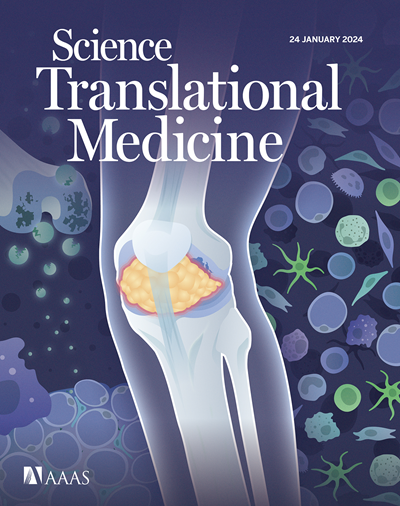Myeloma interaction with bone marrow stromal cells suppresses ciliogenesis and osteogenic potential in myeloma bone disease
IF 14.6
1区 医学
Q1 CELL BIOLOGY
引用次数: 0
Abstract
Myeloma bone disease, a complication of multiple myeloma (MM), is characterized by impaired osteogenic function of bone marrow stromal cells (BMSCs) and can be an indicator of disease progression. The underlying mechanisms driving BMSC dysfunction are not yet fully understood. This work investigated MM cell interaction with BMSCs, finding that BMSC ciliogenesis is inhibited in the presence of myeloma cells. We demonstrated that direct interaction between myeloma cells and BMSCs through CD40-CD40L led to BMSC down-regulation of sentrin-specific protease 1 (SENP1), a cysteine protease that removes small ubiquitin-like modifier (SUMO) posttranslational modifications. SENP1 down-regulation led to increased SUMOylation of oral-facial-digital syndrome type 1 protein (OFD1), a centriole and centriolar satellite protein, at K931. Increased SUMOylation led to increased OFD1 protein stability and localization at centriolar satellites of primary cilia and decreased ciliogenesis. Consequently, BMSCs lacking primary cilia became desensitized to shear stress stimulation and decreased Hedgehog signaling activation. This cascade of events resulted in inhibited ciliogenesis and osteogenesis in myeloma-BMSC–interacting models, in Prx1CreCd40lf/f mice, and in clinical samples. Treatment with an anti-CD40 neutralizing antibody effectively mitigated bone disruption and tumor burden in the Vk*MYC and SCID (severe combined immunodeficient)–hu mouse models of MM. Overall, our study provides experimental insights into BMSC dysfunction in MM and suggests that targeting the CD40-SENP1-OFD1 axis could hold promise for MM treatment in clinical settings.
骨髓瘤与骨髓基质细胞的相互作用抑制骨髓瘤骨病的纤毛发生和成骨潜能
骨髓瘤骨病是多发性骨髓瘤(MM)的一种并发症,其特征是骨髓基质细胞(BMSCs)的成骨功能受损,可以作为疾病进展的一个指标。驱动BMSC功能障碍的潜在机制尚不完全清楚。这项工作研究了MM细胞与骨髓间充质干细胞的相互作用,发现骨髓间充质干细胞的纤毛发生在骨髓瘤细胞的存在下受到抑制。我们证明,骨髓瘤细胞与骨髓间充质干细胞之间通过CD40-CD40L直接相互作用导致骨髓间充质干细胞下调SENP1特异性蛋白酶1 (SENP1),这是一种半胱氨酸蛋白酶,可去除小的泛素样修饰物(SUMO)翻译后修饰。SENP1下调导致K931口-面-指综合征1型蛋白(OFD1) sumo化增加,OFD1是一种中心粒和中心粒卫星蛋白。sumo化的增加导致OFD1蛋白的稳定性和定位在初级纤毛的中心中心卫星上增加,并减少纤毛的发生。因此,缺乏初级纤毛的骨髓间充质干细胞对剪切应力刺激变得不敏感,并且减少了刺猬信号的激活。在骨髓瘤-骨髓间质干细胞相互作用模型、Prx1 Cre Cd40l f/f小鼠和临床样本中,这一系列事件导致纤毛发生和成骨发生受到抑制。抗cd40中和抗体治疗可有效减轻Vk*MYC和SCID(严重联合免疫缺陷)-hu MM小鼠模型的骨破坏和肿瘤负担。总体而言,我们的研究提供了MM中BMSC功能障碍的实验见解,并表明靶向CD40-SENP1-OFD1轴可能在临床治疗MM中有希望。
本文章由计算机程序翻译,如有差异,请以英文原文为准。
求助全文
约1分钟内获得全文
求助全文
来源期刊

Science Translational Medicine
CELL BIOLOGY-MEDICINE, RESEARCH & EXPERIMENTAL
CiteScore
26.70
自引率
1.20%
发文量
309
审稿时长
1.7 months
期刊介绍:
Science Translational Medicine is an online journal that focuses on publishing research at the intersection of science, engineering, and medicine. The goal of the journal is to promote human health by providing a platform for researchers from various disciplines to communicate their latest advancements in biomedical, translational, and clinical research.
The journal aims to address the slow translation of scientific knowledge into effective treatments and health measures. It publishes articles that fill the knowledge gaps between preclinical research and medical applications, with a focus on accelerating the translation of knowledge into new ways of preventing, diagnosing, and treating human diseases.
The scope of Science Translational Medicine includes various areas such as cardiovascular disease, immunology/vaccines, metabolism/diabetes/obesity, neuroscience/neurology/psychiatry, cancer, infectious diseases, policy, behavior, bioengineering, chemical genomics/drug discovery, imaging, applied physical sciences, medical nanotechnology, drug delivery, biomarkers, gene therapy/regenerative medicine, toxicology and pharmacokinetics, data mining, cell culture, animal and human studies, medical informatics, and other interdisciplinary approaches to medicine.
The target audience of the journal includes researchers and management in academia, government, and the biotechnology and pharmaceutical industries. It is also relevant to physician scientists, regulators, policy makers, investors, business developers, and funding agencies.
 求助内容:
求助内容: 应助结果提醒方式:
应助结果提醒方式:


